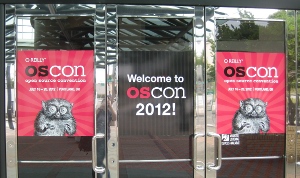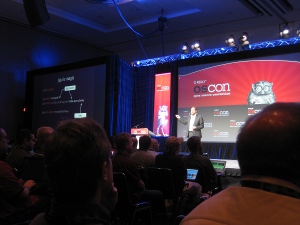Although I’ve always wanted to go, I hadn’t actually planned on attending OSCON this year due to several factors (work, budget, etc). That changed when I received the email about winning the Open Source Award on July 9th, I was able to quickly schedule a couple days off of work to attend the last two days of the conference and accept the award. I arrived at the conference center on Thursday morning.
Thursday morning started off with a keynote by our very own Mark Shuttleworth, who spoke about and demoed juju, went into his long term vision for Unity on the desktop and beyond and introduced the new Ubuntu Web Apps (discussed here on the Canonical blog).
The second keynote, Open Source: A Recipe For Success by John Mone is also worth mentioning. He discussed ways in which open source is changing small business, making it significantly easier and cheaper to start your own website for your business, and shared the following stats for “Startup Costs” for a small company online:
2000:
- 50mb Hosting Account $20/mo.
- Shopping Cart $1,000
- SQL Server License $1,800
- Email Accounts $1,500
2012:
- Bluehost Hosting Account ~$5/mo.
- Open source tools Free
- One-click installation Free
“Today, users get all the solutions they need and reliable web hosting for the cost of a latte per month.”
I certainly know some of the benefits of open source for SMBs, as my day job almost exclusively is tied to doing open source deployments for SMBs, but I hadn’t recently stopped to not only compare current open source vs. proprietary solutions, but also to consider that 12 years ago there simply weren’t open source solutions for the most common things a little online start-up may need. I highly recommend checking out the slides (linked above) for some other interesting stats he presented, and the results are also covered in this eWeek article.
After the keynotes wrapped up, it was off to the first talks of the day! I selected Girl Developers will Save the World! presented by Cheryl Miller of greenlight for girls. I hadn’t heard of the program before, and it was exciting to learn that they were doing an event for girls there at OSCON. Miller’s talk covered hopes for getting more girls involved at a young age and the importance of starting while they’re young. She also explored some of the reasons for low representation of women in STEM and potential solutions (including controversial ones like government-mandated quotas). I think what struck me most about this session was that it was overwhelmingly attended by females, most of the audience members who spoke up were male, offering a textbook case of what tends to happen in mixed gender environments when technology is the subject, and why it’s important to have some girls-only events.
The next session I attended was US Government v. Open Source: A History and Lessons Learned by Karl Fogel and Gunnar Hellekson. Their presentation centered around the timeline being compiled at gov-oss.org and discussed some of the major points for Open Source in the US Government, both in terms of releasing it and using it. What’s most notable is that the federal government actually does use a large amount of OSS, and has for many years at the urging of several key technologists within the government.
Next up was When Cloud Networking meets Cloud Computing: Software-Defined Networking (SDN) by Mike Cohen and Faan DeSwardt. The talk really focused on the OpenFlow technology, and DeSwardt described a real world case in which the high availability of services (including CPU and RAM management) and storage had been solved, but network woes were becoming the new blocker for cloud scaling. I then went to the overflowing Development is Production Too talk by John Goulah and Erik Kastner where they examined some best practices for deploying and running development environments. They discussed deployment of development infrastructures and tools to developers, benefits and drawbacks of shared development environments, importance of reusing of as much configuration management infrastructure from production as possible and some of the strategies for what data should be used when testing (snapshot of production data shared on the development network? subset of data referenced locally?). I then attended Allison Randal’s Ubuntu Home Hacks talk. It was another packed room and a lot of fun! She showed off the Arduino devices and software tools she used for home automation and monitoring of things like indoor temperature and outside weather, much of it linked here. The last talk I attended was Frequently Asked and Infrequently Answered Questions About Software Patents with Mishi Choudhary, Deb Nicholson and Justin Colannino. Much of what was discussed I was already familiar with, but I didn’t know much about Defensive Publications prior to this talk, or that there were organizations out there that would help Open Source projects file them.
In addition to talks, I also got to check out the expo hall. I talked to the Linbit folks about new features in DRBD, including some of their replication scaling plans (cool!) and I got myself a nice DRBD t-shirt. I was also able to say hello to the Linode folks, and swung by the Linux New Media booth and they were kind enough to give me a copy of the latest Ubuntu User Magazine when I showed them I was in it:
Presenting updates about Xubuntu at UDS! Thanks again to Benjamin Kerensa for submitting that photo along with his article.
Friday was the last day of the conference, there were some amusing keynotes, including one by Chris DiBona of Google on M-Lab where he shared some statistics about internet speeds gathered from the project and encouraged attendees to get involved. The first talk I attended was Bringing the Open Source to the Enterprise! An incomplete story by Mohamed Elmallah where he discussed his experiences promoting and deploying Open Source solutions in companies he’s worked for, including challenges he’s faced with maturity of projects, quality of support, polish/prettiness of the applications and how they’ve compared to their proprietary counterparts. He wrapped up by saying that they would often go with “open enough” solutions when full Open Source wouldn’t do, like proprietary solutions that offered extensive APIs, and would often end up with a blend of proprietary and Open Source solutions. I then went to Running a high performance LAMP stack on a $20 Virtual server by Jay Janssen. His tips included using something like Lighttpd to serve static content (just passing non-static to Apache), using a caching server like Varnish or caching service like CloudFlare. He also went into some ways you could tune Apache’s worker settings when using mod_php, and ways to avoid using mod_php and tune MySQL for better performance. It is interesting to note that all of his solutions included using Apache rather than switching entirely to another webserver. The last talk of the day I could only attend part of, but I chose to go with How To Multiply Your Community By A Factor Of X with Brian King and Benjamin Kerensa. The portion of the session I was able to attend really focused on the basics of the Mozilla Reps program and some of the challenges they’ve faced.
It was then off to the keynote room so I could meet up with the folks organizing the Open Source Award presentation. It was a pleasure to meet the organizers and my fellow award winners during the time we had before the presentation and they gave us a quick rundown of how the presentation would work.
The video of the Open Source Awards is now up on youtube here: OSCON 2012: O’Reilly Open Source Awards.
Since the award is a lightbulb and I had to fly home, they offered to have it shipped to me and I took them up on the offer upon realizing how impossible it would be to check it and the risk I’d be taking if I tried to carry it on (they aren’t explicitly prohibited in carry on luggage, but the TSA has flexibility when it comes to determining what they feel may be dangerous).
With OSCON wrapped up, I headed back to my hotel for some touristing around Portland, but that’s for another post!







Tuesday, Jul 24th, 2012 at 4:28
Congrats! You totally deserve it!
I look forward to many more years of fantastic achievements!